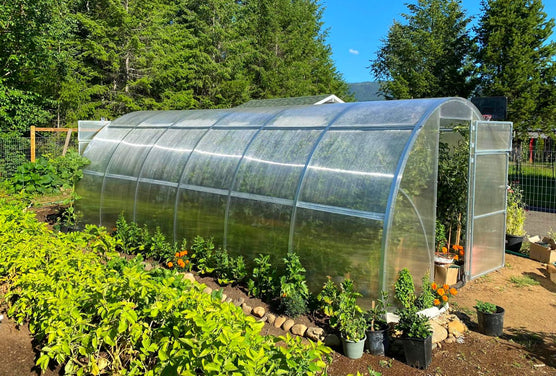Customized to Excellence: Monarch Custom Greenhouse Utah Workmanship
Wiki Article
The Future of Greenhouses: Developments in Sustainable Farming
Are you curious regarding the future of greenhouses and how they are revolutionizing lasting agriculture? From advanced climate control systems to upright farming techniques, water-efficient irrigation methods, renewable energy integration, and clever information analytics, these advancements are transforming the method we expand our food.Advanced Climate Control Systems
To attain ideal growing conditions, you can depend on the advancements in greenhouses with advanced environment control systems. These systems have actually revolutionized the way we cultivate crops, offering a regulated atmosphere that is favorable to plant development. With these innovative systems, you can currently control temperature, moisture, light degrees, and even carbon dioxide concentrations to develop the perfect conditions for your plants to thrive.Among the crucial functions of these advanced climate control systems is their ability to regulate temperature. By making use of sensors and automated controls, the greenhouse can readjust the temperature level based upon the details requirements of the plants. This makes certain that they are never exposed to severe warmth or cold, which can be detrimental to their growth.
Moisture control is an additional vital aspect of these systems. By preserving the optimal humidity degrees, you can protect against issues such as mold and mildew, mold, and disease from impacting your crops. These systems can also regulate the amount of light that reaches the plants, guaranteeing that they obtain the optimal quantity for photosynthesis.
Additionally, advanced climate control systems can also adjust CO2 concentrations. By boosting the degrees of carbon dioxide in the greenhouse, you can boost plant development and performance. This is specifically valuable in areas with reduced all-natural carbon dioxide degrees.
Upright Farming Methods
One crucial vertical farming technique is using stacked expanding systems. Piled expanding systems are generally utilized in city areas where room is restricted.One popular method is called vertical hydroponics, where plants are expanded in nutrient-rich water without soil. This method is highly effective as it minimizes water usage by up to 90% compared to conventional farming approaches. In addition, considering that the plants are expanded inside, they are protected from illness and parasites, decreasing the need for pesticides.
An additional strategy is aeroponics, which involves suspending the plant origins in a mist or air setting. This technique allows for ideal nutrient absorption and oxygenation, resulting in faster development and greater yields. Aeroponics likewise makes use of less water than standard farming and can be executed in upright systems, making it a prominent selection for upright farming.
Water-efficient Irrigation Techniques
When it comes to executing water-efficient irrigation approaches in sustainable farming,Taking full advantage of water preservation is crucial. With global water scarcity becoming a pushing problem, it is critical to develop ingenious techniques that optimize water usage in greenhouse operations.One promising approach is drip irrigation, which delivers water directly to the plant origins, reducing waste and dissipation. By utilizing a network of tubes with tiny emitters, water is applied gradually and exactly, making certain that plants obtain the required dampness without excess drainage.
One more efficient strategy is making use of dirt wetness sensing units. These tools gauge the moisture content in the soil and supply real-time data to farmers. By monitoring the dirt's dampness degrees, farmers can precisely establish when and just how much water to use, protecting against over-irrigation.
Additionally, the application of rainwater harvesting systems is gaining appeal in greenhouse agriculture. Collecting rain from rooftops and keeping it in storage tanks allows farmers to use this natural deposit for irrigation objectives, reducing reliance on typical water resources.
Finally, the fostering of automated irrigation systems can considerably enhance water effectiveness. These systems utilize sensing units to spot dirt dampness degrees and weather, readjusting irrigation schedules as necessary. By optimizing water use based upon real plant requirements, these systems can reduce water waste and advertise lasting farming practices.
Renewable Power Integration
Eco-friendly energy assimilation in greenhouses offers numerous benefits, including decreased running prices and decreased reliance on non-renewable power sources. The generated power can after that be used to run various procedures within the greenhouse, such as heating, ventilation, and illumination systems. These turbines harness wind power and convert it right into electrical energy, which can be made use of to supplement the energy requirements of the greenhouse.Smart Data Analytics and Automation
To enhance the performance of your greenhouse operations and maximize source usage, take into consideration executing clever information analytics and automation. Smart information analytics includes collecting and evaluating data from different sensors and devices within your greenhouse.
Automation, on the other hand, involves using technology to automate jobs that were formerly done by hand. This can include automating the control of illumination, ventilation, irrigation systems, and nutrient Monarch Greenhouse Sheds Utah delivery. By automating these procedures, you can ensure that your plants receive the right conditions and nutrients at the best time, without the need for constant hand-operated treatment. This not only saves you time and effort yet additionally minimizes the danger of human error.
Moreover, clever data analytics and automation can work together synergistically. The information accumulated by sensors can be made use of to educate computerized systems, enabling them to make real-time adjustments based upon the current problems. This combination of information analytics and automation can cause much more specific and effective resource appropriation, eventually resulting in greater returns and much better crop top quality.
Conclusion
Finally, the future of greenhouses in lasting agriculture looks promising. With innovative climate control systems, upright farming techniques, water-efficient irrigation approaches, and renewable resource assimilation, greenhouses are ending up being extra environmentally friendly and reliable. Additionally, making use of smart data analytics and automation additionally enhances efficiency and minimizes waste. These technologies are paving the method for a much more lasting and efficient farming sector, guaranteeing a greener and healthier future for all.
By optimizing water usage based on actual plant needs, these systems can decrease water waste and promote sustainable farming techniques.

Report this wiki page